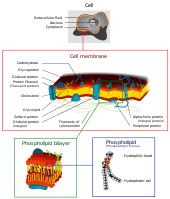
Photo from wikipedia
Membrane fusion is fundamental to biological activity of cells, so disclosingits relevant mechanism is very important for understanding various cell functions. Although artificial model systems have been developed to uncover… Click to show full abstract
Membrane fusion is fundamental to biological activity of cells, so disclosingits relevant mechanism is very important for understanding various cell functions. Although artificial model systems have been developed to uncover the mechanism of membrane fusion, key factors determining the mode of membrane fusion remain unclear. Based on the construction of different types of liposome vesicles, we used a dynamic fluorescence imaging method to investigate the effect of membrane protein distribution density on membrane fusion. Time-resolved imaging revealed that protein-free pure phospholipid vesicles themselves occurred full membrane fusion. Moreover, we prepared proteoliposomes with increasing protein-to-lipid ratio to better reflect the characteristic of membrane structure in vivo. Our data showed that pure phospholipid vesicles no longer fused with the proteoliposomes that in a higher protein proportion, indicating dense membrane proteins may hinder membrane fusion. A further comparative analysis of the interactions of pure phospholipid vesicles with the cell membrane / giant plasma membrane vesicles (GPMVs) / protein-free giant unilamellar vesicles (GUVs) confirmed the inhibitory effect of dense membrane proteins on membrane fusion. Our work demonstrates the membrane protein density influences the mode of membrane fusion and lays a foundation for constructing quasi-native membrane fusion models in vitro.
Journal Title: Talanta
Year Published: 2021
Link to full text (if available)
Share on Social Media: Sign Up to like & get
recommendations!